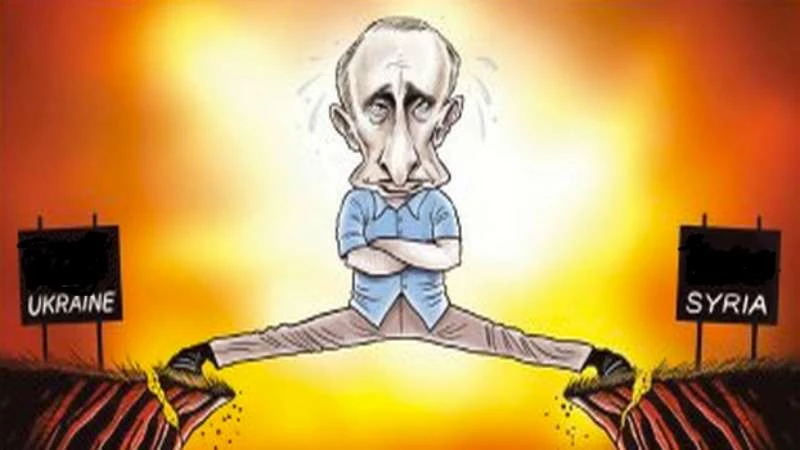Both countries now have a ceasefire in place, negotiated in Geneva, respectively Minsk, being supported by the international community and working “more or less” with some violations by the respective aggressor and “much less violence than before,” meaning some killed children here and a some dead soldiers there. At the same time, both countries and both ceasefires suffer under the same main factor: Russia, the country that claims to observe the “reconciliation between the warring parties” in Syria and being “no party in the conflict” in Ukraine. Russia not just brought much to most of the violence and suffering to the two nations; it also−at least behind the scenes−dictated the conditions of the two current ceasefires to its and its proxies’ advantage on both continents.
Both, in Syria and Ukraine, Russian ground troops are now stationed on the ground at the former hotspots of the fighting, “observing the implementation of the ceasefire,” which in both cases led to one result mainly (in Ukraine since 2014, in Syria since February and even more since last Monday): Only the party, not supported by Mr. Putin is responsible for each and every breach of the ceasefires while his proxies−Assad and Iran in Syria and the so-called peoples’ republics’ of Donetsk and Luhansk in Ukraine−are portrayed as peaceful entities, interested in maintaining the Russian-brokered truces.
In both cases, this is a lie, as the world knows but never expresses loudly to not “further provoke” Russia. In Syria, the Assad regime conducted multiple air strikes and artillery attacks over the last 4 days, not to speak of the thousands of civilian deaths since the “Cessation of Hostilities” started in February. And also in eastern Ukraine, pro-Russian forces and their Russian Army commanders are the main source of ceasefire violations as several reports indicate. And while the observing OSCE representatives officially claim, “both sides” are violating the truce, key officers of the organization admit in high-level off-record talks that most of the fighting is initiated by Russia’s local fighters and allies on the ground.
And there is another parallel, making Syria’s poisoned Geneva ceasefire and that of Ukraine’s equally intoxicated Minsk peace plan comparable. Russia not just excuses and hides one side’s violations while crying foul about the other side almost daily. It also keeps its finger on the trigger, being able to fuel the conflicts whenever it feels to do so. In the case of Ukraine, strategic aspirations like the desired capture of the city of Debaltseve or the airport of Donetsk as well as prolonged sanctions by the West led to upticks in violence, sometimes short-lived, sometimes claiming hundreds of lives. In Syria, the “coming under fire” at the Castello road to besieged eastern Aleppo could have been the first case of upping the pressure (by further starving innocent civilians) while blaming the other side. It remains to be seen if under the latest Syria ceasefire, combined Russian-Assad offensives will take place like under the February one and like Ukraine has seen in January and February 2015.
In the end, Russia just doubled its global pressure potential by adding another dirty “ceasefire” to its arsenal of bargains. If the West acts in Russia’s favor, this will lead to less violence and a “working ceasefire” in Syria while Western actions not endorsed by Russia will lead to more violence and the Kremlin blaming everyone but its own proxies for the escalation. In this regard and despite different conditions and parties on the ground, Ukraine and the Minsk agreement might have been a blueprint for Russia’s “ceasefire” proposal in Syria. As the West is not interested in more conflict with Russia and rather appeases the country furthermore−which only led to new Russian adventures so far−Russia’s geopolitical position is becoming stronger and stronger by each new “ceasefire” it participates in. While it signed the Minsk treaty with Ukraine, Germany and France, it only had one other signer of the Geneva ceasefire for Syria, which was the US. This reduction and diversification of negotiation partners with Russia as the only constant is exactly what the Kremlin reached for to look stronger in the international field. Russia remains the main parallel between the wars and ceasefires in Syria and Ukraine as both, the aggressor and guarantor of peace−a fatal combination.
-------------------------------------------
Julian Röpcke is a newspaper editor and political commentator, based in the German capital, Berlin. With a degree in Political Geography and Sociology, Mr. Röpcke started analyzing geopolitical conflicts after the US-led invasion of Iraq in 2003. He covered the “Arab Spring” as well as the evolving conflicts in Syria and Ukraine from their very beginning. Julian Röpcke works for BILD, the largest newspaper and leading online news portal in Germany (@JulianRoepcke).



التعليقات (0)